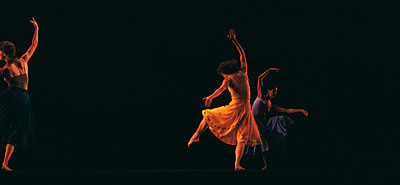Dance Oasis
An oasis has grown up in an unlikely place during the 20-year financial and cultural drought that is wracking American dance. Every summer, some of the world’s best dancers and choreographers escape to blue-collar central Maine for creative nourishment and renewal, away from the stresses of their endangered, highly competitive discipline.

A 1984 performance by Dan Wagoner and Dancers, photographed by Leonard Plavin, husband of Bates Dance Festival co-founder Marcy Plavin.
“The Bates Dance Festival has emerged as one of the three most important dance festivals in the United States,” says dance critic and scholar Suzanne Carbonneau ’76.
Both schools and venues for concert presenters, dance festivals are essential to the art. “They are places where new work gets presented and commissions happen,” Carbonneau said. “They are where the vital work of the field is showcased.”
As it approaches its silver anniversary season, the Bates Dance Festival equals two older and larger dance stalwarts, Jacob’s Pillow and American Dance Festival, in the quality of its artists and performances. Carbonneau, who participates in all three festivals, says the BDF is uniquely cherished as an artists’ community akin to the legendary Black Mountain and Bauhaus schools. “Dancers, teachers, musicians, and choreographers live, eat, and work together. They mix it up and it becomes a cauldron of creativity. It is a utopian vision of what an artist’s life should be.”
Meanwhile, BDF’s worth has risen as other festivals and many dance companies have shrunk and sunk. Dance, always the poorest of the arts, was hit hard when Congress slashed the National Endowment for the Arts budget in the 1990s. Not coincidentally, public patience for live, ephemeral performances has also waned.
“Dance is struggling with how to keep itself going,” Carbonneau says. “For artists to have a place where for three weeks they don’t have the career worries, and they can focus on creative time and talk together as colleagues, not competitors, has made Bates more important.”
Perhaps because of the state of dance, the BDF’s reputation for egalitarianism is especially valued.
“The festival emphasizes cooperation and collegiality over competition,” echoes Michael Foley ’89, who choreographs and teaches internationally. Foley attended his first festival as an 18-year-old student of its founder, Marcy Plavin, the beloved professor who almost single-handedly brought dance to Bates College. “The root of Marcy’s philosophy — anyone can dance — is why I felt I could study and thrive there. That egalitarianism has been maintained. There is a place for anyone who has a hunger and passion for dance. That is remarkable. How many places do that? And that reputation is global.”
A typical Bates pragmatism led to the establishment of the festival, in 1982. For several years, then President Reynolds had been pushing for more summer programs to maximize use of the College’s facilities and staff. Back then, some custodial and dining employees would be laid off during the summer. “We lost some excellent workers,” says Judy Marden ’66, an event liaison then and now director of the Bates–Morse Mountain Conservation Area. So summer at Bates in the late ’70s and ’80s saw a slew of new summer programs, everything from a dog show and wheelchair marathon to the annual meeting of the Presbyterian Synod of the Northeast.
Plavin embraced her mission with characteristic focus and energy. With Frank Wicks, a member of the dance community, she recruited a faculty befitting the festival’s motto, “study with the best.”
That first season “had its own special excitement,” Plavin recalls. “Will it run? Will it work? Will it be just a one-year thing and die away? We were very green, but we felt we could do it.” Composition instructor David Gordon’s handling of a scheduling miscue was typical of the plucky enthusiasm that permeated the campus. Arriving to find his classroom filled with tables for another event, Gordon incorporated the furniture into the lesson. “We danced on the tables and around them,” Plavin laughs.
Plavin is not surprised that the world’s dancers hold BDF in high esteem today. Lasting just three weeks, the professional training component is uniquely convenient, so it has not been difficult attracting top-notch faculty, which in turn draws promising students. (There are 60 artists-in-residence and 190 students.)
Laura Faure observes her own milestone this summer: her 20th as BDF’s director. Under her strategic leadership, BDF began commissioning works and offering residencies to emerging artists from all over the world. In 1996, with Michael Foley, she founded the Young Dancers Workshop for teenagers (it runs two weeks prior to the festival proper). Egalitarianism, meanwhile, is ever the core strength. “Anyone can go into the dining room and sit with anyone else,” Faure says. “There is no stratification. There are parties, jam sessions, informal showings. The structure encourages engagement.”
The festival’s sense of fair play embraces the Lewiston-Auburn community as well, with the Youth Arts Program assembling local children and world-class artists for lecture series and informal showings. Observed Carbonneau, “It’s a statement about dance’s role in the larger world: dance’s impact is not just on the professionals involved in it.”
Dervilla McCann ’77, another Plavin protégé, is now a cardiologist in Lewiston and member of the BDF Advisory Council. She sees her role as helping Faure extend the festival’s inclusive umbrella to dance-deprived Maine audiences. She talks about the festival to colleagues and patients (“one-on-one conversations are effective”) and has advocated for brief explanatory text in performance programs. “Dance can be viewed as an elitist, esoteric art form,” she says. “I want audiences to feel welcome and engaged, not confronted and put off. We’re creating a space that’s a nurturing one for the audience as well as the artists.”
Freelance writer Virginia Wright lives in Cumberland, Maine.